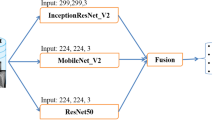Abstract
Chronic respiratory diseases are very prominent now a days, these lung diseases become severe if not treated on time and may lead to lung cancer. National Cancer Registry Programme, India reported that 49.2% of males and 55.2% of females had been diagnosed with lung cancer in the year 2021. Considering lung abnormalities as a serious problem, In the proposed paper, we come up with a deep ensemble architecture as well as the approach for the data creation. An artificial intelligence (AI) based deep ensembled model is developed which identifies the abnormalities like Cardiomegaly, Collapse, Reticulonodular Pattern, Consolidation, Calcification, Bronchitis, Nodule, Osseous Lesions, Support devices and Pleural Effusion etc. The model also localizes the accurate position where the problem occurs. The mAP values obtained from the localization model on supervised and weakly supervised data are 0.323 and 0.376 respectively.
Supported by organization L &T Technology Services.
Access this chapter
Tax calculation will be finalised at checkout
Purchases are for personal use only
Similar content being viewed by others
References
Wu, J., et al.: Automatic bounding box annotation of chest x-ray data for localization of abnormalities. In: 2020 IEEE 17th International Symposium on Biomedical Imaging (ISBI). IEEE (2020)
Schwab, E., et al.: Localization of critical findings in chest X-ray without local annotations using multi-instance learning. In: 2020 IEEE 17th International Symposium on Biomedical Imaging (ISBI). IEEE (2020)
Guo, R., Passi, K., Jain, C.K.: Tuberculosis diagnostics and localization in chest X-Rays via deep learning models. Front. Artif. Intell. 3, 74 (2020)
Candemir, S., Antani, S.: A review on lung boundary detection in chest X-rays. Int. J. Comput. Assist. Radiol. Surg. 14(4), 563–576 (2019). https://doi.org/10.1007/s11548-019-01917-1
Chandra, T.B., et al.: Localization of the suspected abnormal region in chest radiograph images. In: 2020 First International Conference on Power, Control and Computing Technologies (ICPC2T). IEEE (2020)
Wang, X., et al.: Chestx-ray8: Hospital-scale chest x-ray database and benchmarks on weakly-supervised classification and localization of common thorax diseases. In: Proceedings of the IEEE Conference on Computer Vision and Pattern Recognition (2017)
Zhao, Z.Q., et al.: Object detection with deep learning: a review. IEEE Trans. Neural Netw. Learn. Syst. 30(11), 3212–3232 (2019)
Li, Z., et al.: CLU-CNNs: object detection for medical images. Neurocomputing 350, 53–59 (2019)
Kim, Y.-G., et al.: Deep Learning-based Four-region Lung Segmentation in Chest Radiography for COVID-19 Diagnosis. arXiv preprint arXiv:2009.12610 (2020)
Ajad, A., Gupta, S., Sadhwani, K.J.: CARES: knowledge infused chest X-ray report generation scheme. In: RSNA 2020–106th Annual Meeting (2020)
Pradhan, J., Ajad, A., Pal, A.K., Banka, H.: Multi-level colored directional motif histograms for content-based image retrieval. Visual Comput. J. 36(9), 1847–1868 (2020)
Chen, X., Gupta, A.: An implementation of faster rcnn with study for region sampling. arXiv preprint arXiv:1702.02138 (2017)
Cheng, B., et al.: Revisiting rcnn: on awakening the classification power of faster rcnn. In: Proceedings of the European Conference on Computer Vision (ECCV) (2018)
Girshick, R.: Fast r-cnn. In: Proceedings of the IEEE International Conference on Computer Vision (2015)
Li, X., et al.: H-DenseUNet: hybrid densely connected UNet for liver and tumor segmentation from CT volumes. IEEE Trans. Med. Imaging 37(12), 2663–2674 (2018)
Akcay, S., Breckon, T.P.: An evaluation of region based object detection strategies within x-ray baggage security imagery. In: 2017 IEEE International Conference on Image Processing (ICIP). IEEE (2017)
Purkait, P., Zhao, C., Zach, C.: SPP-net: deep absolute pose regression with synthetic views. arXiv preprint arXiv:1712.03452 (2017)
Wang, X., et al.: Data-driven based tiny-YOLOv3 method for front vehicle detection inducing SPP-net. IEEE Access 8, 110227–110236 (2020)
Fang, Y., et al.: Accurate and automated detection of surface knots on sawn timbers using YOLO-V5 model. BioResources 16(3), 5390–5406 (2021)
Wen, L., Li, X., Gao, L.: A transfer convolutional neural network for fault diagnosis based on ResNet-50. Neural Comput. Appl. 32(10), 6111–6124 (2020)
Torralba, A., Russell, B.C., Yuen, J.: Labelme: online image annotation and applications. Proc. IEEE 98(8), 1467–1484 (2010)
Xu, Q., et al.: Effective face detector based on YOLOv5 and superresolution reconstruction. Comput. Math. Methods Med. 2021 (2021)
Wang, X., et al.: Hospital-scale chest x-ray database and benchmarks on weakly-supervised classification and localization of common thorax diseases. In: IEEE CVPR, vol. 7 (2017)
Rozenberg, E., Freedman, D., Bronstein, A.: Localization with limited annotation for chest x-rays. Machine Learning for Health Workshop. PMLR (2020)
Author information
Authors and Affiliations
Corresponding authors
Editor information
Editors and Affiliations
Rights and permissions
Copyright information
© 2023 The Author(s), under exclusive license to Springer Nature Singapore Pte Ltd.
About this paper
Cite this paper
Ajad, A., Saini, T., Kumar Niranjan, M., Joshi, A., Kumar Swaroop, M.L. (2023). Deep Ensemble Architecture: A Region Mapping for Chest Abnormalities. In: Tanveer, M., Agarwal, S., Ozawa, S., Ekbal, A., Jatowt, A. (eds) Neural Information Processing. ICONIP 2022. Communications in Computer and Information Science, vol 1794. Springer, Singapore. https://doi.org/10.1007/978-981-99-1648-1_28
Download citation
DOI: https://doi.org/10.1007/978-981-99-1648-1_28
Published:
Publisher Name: Springer, Singapore
Print ISBN: 978-981-99-1647-4
Online ISBN: 978-981-99-1648-1
eBook Packages: Computer ScienceComputer Science (R0)




